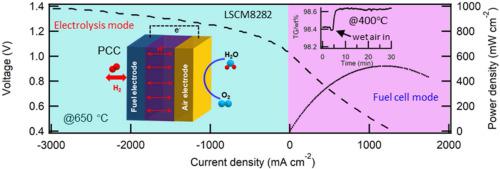Journal of Materiomics ( IF 8.4 ) Pub Date : 2022-02-28 , DOI: 10.1016/j.jmat.2022.02.012 Ning Wang 1, 2 , Chunmei Tang 2 , Lei Du 1 , Zhao-Qing Liu 1 , Weiyan Li 1 , Zhongqian Song 1 , Yoshitaka Aoki 3 , Siyu Ye 1

|
Hydrogen, especially the “green hydrogen” based on water electrolysis, is of great importance to build a sustainable society due to its high-energy-density, zero-carbon-emission features, and wide-range applications. Today's water electrolysis is usually carried out in either low-temperature (<100 °C), e.g., alkaline electrolyzer, or high-temperature (>700 °C) applications, e.g., solid oxide electrolyzer. However, the low-temperature devices usually suffer from high applied voltages (usually >1.5 V @0.01 A cm−2) and high cost; meanwhile, the high-temperature ones have an unsatisfied lifetime partially due to the incompatibility among components. Reasonably, an intermediate-temperature device, namely, proton ceramic cell (PCC), has been recently proposed. The widely-used air electrode for PCC is based on double O2-/e- conductor or composited O2-/e-−H+ conductor, limiting the accessible reaction region. Herein, we designed a single-phase La0.8Sr0.2Co1-xMnxO3-δ (LSCM) with triple H+/O2-/e- conductivity as the air electrode for PCCs. Specifically, the La0.8Sr0.2Co0.8Mn0.2O3-δ (LSCM8282) incorporates 5.8% proton carriers in molar fraction at 400 °C, indicating superior proton conducting ability. Impressively, a high current density of 1580 mA cm−2 for hydrogen production (water electrolysis) is achieved at 1.3 V and 650 °C, surpassing most low- and high-temperature devices reported so far. Meanwhile, such a PCC can also be operated under a reversible fuel cell mode, with a peak power density of 521 mW cm−2 at 650 °C. By correlating the electrochemical performances with the hydrated proton concentration of single-phase triple conducting air electrodes in this work and our previous work, a principle for rational design of high-performance PCCs is proposed.
中文翻译:

单相 La0.8Sr0.2Co1-xMnxO3-δ 电催化剂作为三重 H+/O2-/e- 导体实现高性能中温水电解
氢,特别是基于水电解的“绿色氢”,具有高能量密度、零碳排放和广泛应用的特点,对建设可持续发展社会具有重要意义。今天的水电解通常在低温(<100°C),例如碱性电解槽或高温(>700°C)应用,例如固体氧化物电解槽中进行。然而,低温器件通常会受到高施加电压的影响(通常 >1.5 V @0.01 A cm -2) 和高成本;同时,高温的部分由于组件之间的不兼容而导致寿命不令人满意。合理地,最近提出了一种中温器件,即质子陶瓷电池(PCC)。广泛用于 PCC 的空气电极基于双 O 2- /e -导体或复合 O 2- /e - -H +导体,限制了可接近的反应区域。在此,我们设计了具有三重 H + /O 2- /e -的单相 La 0.8 Sr 0.2 Co 1- x Mn x O 3- δ (LSCM)电导率作为 PCC 的空气电极。具体而言,La 0.8 Sr 0.2 Co 0.8 Mn 0.2 O 3- δ (LSCM8282) 在 400 °C 下以摩尔分数计包含 5.8% 的质子载流子,表明其具有优异的质子传导能力。令人印象深刻的是,在 1.3 V 和 650 °C 下实现了 1580 mA cm -2的高电流密度用于制氢(水电解),超过了迄今为止报道的大多数低温和高温设备。同时,这种PCC也可以在可逆燃料电池模式下运行,峰值功率密度为521 mW cm -2在 650 °C。通过将本工作和我们之前的工作中单相三导电空气电极的水合质子浓度与电化学性能相关联,提出了一种合理设计高性能 PCC 的原则。











































 京公网安备 11010802027423号
京公网安备 11010802027423号